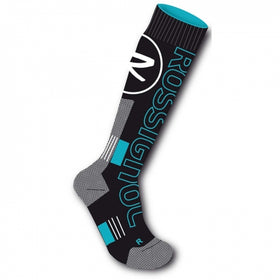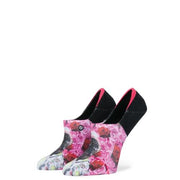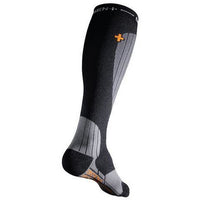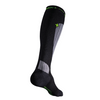NOV 22, 2022
How to Choose Ski Socks
by Braydan Guy
A proper ski sock is one of the easiest and most economical ways to keep your feet comfortable and warm inside your ski boots. Having multiple pairs of ski socks is essential, especially if you plan on skiing at least a few days in a row. No one wants to be doing laundry on their vacation. Clean ski socks always wick moisture away more efficiently and feel better on your skin.

Why Buy a Ski or Snowboard Sock?
While some folks might think a thicker sock is inherently linked to more warmth, the opposite is true for the vast majority of skiers and snowboarders. A thicker sock cannot wick away moisture as effectively as a thinner sock, leading to a colder foot in the long run. Warmth in a ski or snowboard boot will come in the form of ski socks that can insulate and wick away moisture effectively.
The sock's function is simply to provide a wicking surface with a proportional level of insulation that will promote proper blood flow. This creates a dry surface at the foot, providing ample warmth. A boot that is insulated will keep in this heat while allowing water vapor to escape effectively. A properly fitting boot that doesn't inhibit circulation is also crucial to ensure warm feet.
Sock Thickness and Cushioning
While most ski and snowboard socks will be thinner than traditional thick winter socks, there are still different weights available - typically ultralight (often with compression), lightweight, midweight, and heavyweight. The heavier the weight, the thicker and more padded the sock. Lighter weight socks offer a more precise fit in your ski or snowboard boots while heavier weight socks give you more cushion.





Snow Socks
Shop NowChoosing the Right Material
Most ski and snowboard socks are made from either merino wool, a synthetic blend—or a hybrid of both. They also include a small percentage of elastane or Lycra spandex to enhance the fit and provide flexibility. Wool and synthetic are similar when it comes to function and durability, so it’s up to you to decide which socks feel best.
Wool: Merino wool is a material that retains its warmth when wet and is naturally odor resistant. Wool also breathes more easily and is known for its ability to wick moisture away from the skin—a key factor in keeping feet dry, warm and happy. Wool takes longer to feel wet because its fibers naturally absorb moisture; in synthetic fabrics, moisture runs across the fiber where you feel it more readily.
Synthetic: Synthetic blends like nylon-polyester have become more popular in recent years, especially as an alternative for people who have sensitive skin or are allergic to wool. Synthetic yarn typically features fibers that trap warmth and wick moisture, giving the material many of the characteristics naturally found in wool. Most synthetics also come with an antimicrobial coating for odor control. Some skiers prefer the feel of synthetic socks, although merino wool is much less itchy than the wool socks of yesteryear.
Cotton: Just say no. No matter how cold it is outside, your feet are bound to get sweaty while skiing or riding. Cotton lacks the wicking properties of wool and synthetic fabrics—leading to wet, cold feet and increasing the potential for blisters.
Heated Ski Socks: Heated Ski Socks are quickly becoming one of the greatest luxuries you can have in skiing. These types of socks typically have a slightly thicker volume underneath the ball of the foot that accommodates a heating element. This heating element has a few discrete wires that leads to a rechargeable battery pack connection up near the calf of the sock. Three or four different heat settings control the amount of heat sent to the element.
Compression Socks: Compression socks have gained popularity lately in all types of sports, and they definitely have benefits for skiers and snowboarders, too. Compression socks can help to increase blood flow to your feet, and as we’ve discussed, proper blood flow and circulation are essential to warm feet while riding. Several companies make compression ski and snowboard socks, these are a great option for folks with poor circulation or who are prone to cold feet.
Size and Fit
Unlike your usual everyday socks, ski and snowboard socks are tailored to fit men, women, kids and people of different sizes. They are not as simplistic as “one size fits all,” so you must emphasize buying the correct size. Women’s socks are designed to fit the contours of their feet, and men’s are designed differently as well, so be cognizant to purchase the right socks based on your gender.
For starters, a longer sock is preferred, as it will reach above your boots and provide more warmth and comfort. Also, you need to ensure that your socks fit properly. If your socks are too loose, then the excess material will cause blisters. Conversely, if your socks are too tight, your feet will not get the proper circulation and will quickly get cold. A general rule is to be aware of your toe fit. There should not be excess material at the end of your toes, but the sock should also not clamp down on your toes and offer no wiggle room.
Conclusion
Choosing the correct sock for skiing or snowboarding is crucial for ensuring a great day on the slopes. One that can manage moisture will offer great performance, even on the coldest days of the year. Remember, a thicker sock doesn't equate to a warmer sock. It's all about construction and how you ski. Make sure to choose the right weight and features that will work towards keeping your feet dry on the mountain.












